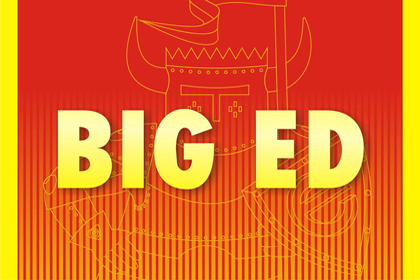
This is the Eduard, Big Ed (BIG 3531), photo etch set for the ‘German Ferdinand‘ from Dragon.
Detail set |
Dragon |
✓ | |||
| (35 462) | Basic | 6133 | |||
| (35 379) | Zimmerit | 6126 | |||
| (XT 066) | Wheel mask | ||||
Source: Eduard
This is the Tamiya 35 072- kit in 1/35 scale, of the ‘Russian Tank Destroyer, SU-85’.
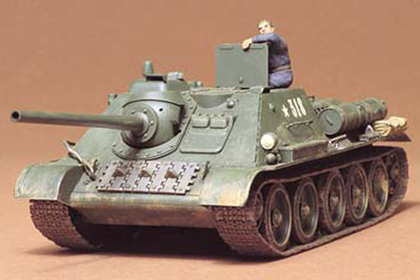
Barely holding back the advancing German forces just before Moscow, the Russian military quickly began to design assault guns. From these designs, the first finished model came loaded on the T-34 chassis with a secured fighting compartment and was armed with an impressive 122mm howitzer. This tank was given the designation SU-122.
Introduced at the Battle of Kursk in 1943, was the newly designed SU-85 which was based on the successful SU-122. It came armed with the D-5S-85A, the 1939 anti-aircraft 51.5 caliber 85mm D-5 gun which was redesigned for anti-tank use. D-5 guns were developed in the same manner as German 88mm anti-tank guns equipped on German Tiger I and Jagdpanther tanks, as both guns were based on anti-aircraft guns.
The SU-85’s armor-piercing shell weighed 9.02 kg, had a velocity of 792 m/s, and could knock out tanks with 100mm thick armor at 1000 m. The SU-85s hull featured a sloped front armor with the fighting compartment offset to the right. After the liberation of Kiev in December 1943, the SU-85 faced off Panther and Jagdtiger tanks and held its own thanks to its 85mm gun.
This is the Dragon 6133 kit in 1/35 scale, of the ‘German Ferdinand’.
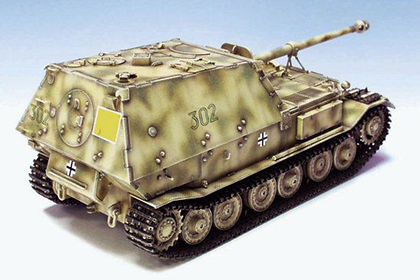
Elefant (German for “elephant”) was a Schwerer Panzerjäger (“heavy tank destroyer”) of the German Wehrmacht used in small numbers in World War II. It was built in 1943 under the name Ferdinand, after its designer Ferdinand Porsche.
In 1944, after modification of the existing vehicles, they were renamed Elefant. The official German designation was Panzerjäger Tiger (P) and the ordnance inventory designation was Sd.Kfz.184.
This is the Dragon 6301 kit in 1/35 scale, of the ‘German Panzerkampfwagen IV, Ausf. E – Vorpanzer’.
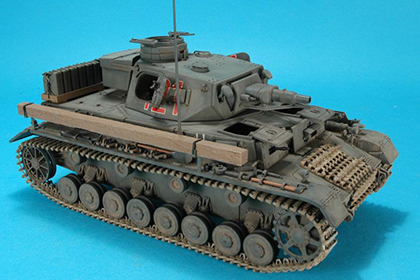
It differed from Zusatzpanzerung because it was spaced from the underlying armour, whereas Zusatzpanzerung was fitted directly onto the armour underneath.Vorpanzer was designed to defeat 105mm HEAT projectiles, and to strip off the piercing caps of APC and APCBC projectiles which would then shatter on the FH armour behind.
It also caused any HE filler in such projectiles to detonate prematurely.
This is the Tamiya 35 236-4000 kit in 1/35 scale, of the ‘JGSDF Type 90 Tank w/Mine Rolle’.

The passive infrared night viewer makes nighttime operations possible. Use of the automatic canon loading system eliminated the need of a loader, reducing the crew from four men to three. A 7.62mm machine gun is mounted a the coaxial position of the main gun, and a 12.7mm machine gun on the turret roof. The tank’s distinctive angular silhouette is due to the full use of Multi-material laminate armor, which provides excellent protection for the crew.
Ammunition stowage at the rear of the turret is completely separated from the crew compartment, thus further improved survivability is obtained. The water-cooled, V-10 cylinder diesel engine is supplied by Mitsubishi Heavy Industry. Equipped with an electronically controlled direct fuel injection, this power unit is capable of yielding 1,500 horsepower, propelling the 50 ton heavy tank up to a top speed of 70km/h they hydraulic suspension is incorporated on four road wheels out of six on either side, thus allowing the tank’s attitude to be adjusted according to the surrounding terrain.
This is the Dragon 6691 kit in 1/35 scale, of the ‘German RSO/01 Type 470’.

The acronym RSO stands for Raupenschlepper Ost, which translates as ‘Caterpillar Tractor East’. The terrible muddy and icy conditions experienced on the Eastern Front convinced Germany of the need for a highly mobile, tracked vehicle.
Steyr proposed the RSO and it immediately became a popular vehicle thanks to its mobility and reliability. In all, about 23,000 RSO vehicles were produced by a range of manufacturers.
The original version had a pressed-steel cab and a typical truck-style cargo bed at the rear. It was powered by a Steyr 85hp V8 engine that offered a top speed of 30km/h. This kit depicts the standard RSO/01, the type with rounded steel cab being the best known of all the versions used by Germany.
This is the Tamiya 35 211-3900 kit in 1/35 scale, of the ‘Russian Heavy Tank, JS-3 (Tamiya)’.
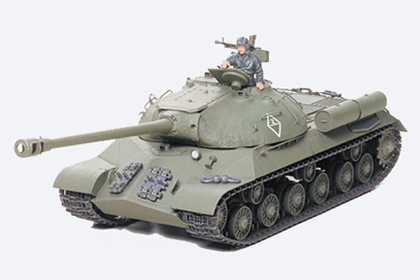
The 520 horsepower diesel engine provided 40km/h of maximum speed. With the concerted effort of the talented Russian tank engineers such as N.L Jukhov and Z.A Kotin, the prototype was completed in October 1944 and the mass production began in the following year.
There have been a lot of controversy concerning whether or not the JS-3 saw any fighting during the Berlin campaign. At least one regiment was equipped with the JS-3 by then, but it’s still uncertain if they were committed to the actual fighting. Other sources claim that it was first deployed in combat against the Japanese in Manchuria in August 1945.
Incorporating several modifications, its production was continued until 1951 and about 1,800 JS-3’s were produced. Its simple and effective turret and hull configuration deeply influenced not only the following Russian tanks, but also fighting vehicles of the western nations.
This is the Tamiya 35 177-4100 kit in 1/35 scale, of the ‘German Sturmtiger, 38cm Assault Mortar’.
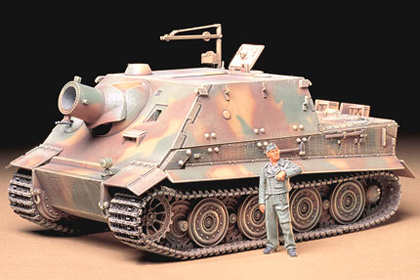
In order to withstand the heavy recoil of up to 40 tons, the Tiger I’s sturdy chassis was selected. A decision was made to use only those chassis/hulls that were sent back from the front, so that new production of the tank would not be affected.
A fighting compartment was formed of a boxlike superstructure which was bolted to the lower hull itself. Its armor plate measured 150mm thick at the front and 80mm on the sides. Later, a steel ring counterweight was added to the mouth of the mortar barrel on some vehicles to make elevation aiming easier.
The mortar’s huge self propelled rocket projectile was 149cm long and weighed 330kg. For loading these heavy rockets aboard, a hand cranked crane was mounted to the right aft side of the upper hull. Due to the rocket’s size, storage space was very limited and only 14 shells could be carried.
Conversion production of the Sturmtiger began in August 1944, and by the end of December a total of 18 units had been completed and sent to the front for action during the final stage of the conflict.
This is the Lifecolor CS-03 paint set, with colors for ‘German Tanks’.
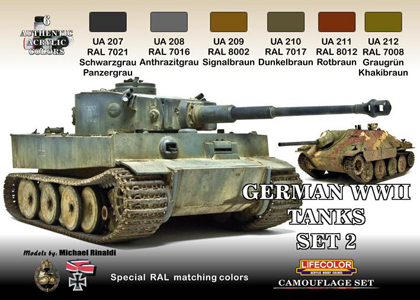
This is the Lifecolor CS-01 paint set, with colors for ‘German Tanks’.
